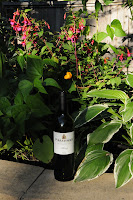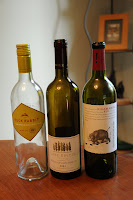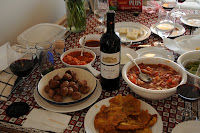 Jackpot!! It was time for Lady Di and She Who Must Be Obeyed to host the Dinner Club and wow us with their culinary talents. The Lady invited a few extra guests in addition to the regular four couples. After all, if you're already cooking for eight, what's another four?
Jackpot!! It was time for Lady Di and She Who Must Be Obeyed to host the Dinner Club and wow us with their culinary talents. The Lady invited a few extra guests in addition to the regular four couples. After all, if you're already cooking for eight, what's another four?What it meant for The List though was that there was a bona fide plethora of wines in the evening's line-up. Between opening cocktails and the multiple courses, there was a full dozen wines being served through the evening. It's a good thing that the evening carried on for hours and there was plenty of cool white wine to help with the warm weather.
 Taking full advantage of that weather and the fact that their building has a wonderful common garden patio, Lady Di found a way to seat us outside in a most delightful setting. There was even a small musical interlude of a little Simon & Garfunkle (for those old enough to remember) as two of the guests found sage, rosemary and thyme right behind their seats in the garden. I'm sure there might have been some parsley there as well had we searched a little longer.
Taking full advantage of that weather and the fact that their building has a wonderful common garden patio, Lady Di found a way to seat us outside in a most delightful setting. There was even a small musical interlude of a little Simon & Garfunkle (for those old enough to remember) as two of the guests found sage, rosemary and thyme right behind their seats in the garden. I'm sure there might have been some parsley there as well had we searched a little longer.I'm fairly certain that I was the only guest that tried all 12 wines being poured. I just felt compelled to try every wine if I was going to mention it in the blog and add it to The List. It certainly helped that I was in charge of the corkscrew and delivery of open bottles. I think there was only one or two that almost missed my glass. Let's just say that my good friend, Mr. Tylenol was of some assistance the next morning.
I will add that it's a good thing I'm not presenting tasting notes in this forum because that would have been ever so distracting and, more than likely, a futile exercise as the numbers got a bit higher. However, we did a fine job on the wines and Lady Di and She Who Must did a marvelous job on the menu.
The evening's first wines were served up with three appetizers of seared tuna, a bruschetta of bocconcini and fresh green pea spread and potato latkes with smoked salmon.
124. 2007 8th Generation Pinot Rose (Okanagan)
125. 2008 Blasted Church Mixed Blessings (VQA Okanagan) (Pinot Blanc, Chardonnay, Pinot Gris, Ehrenfelser)
126. NV Gazela Vinho Verde (DOC Vinho Verde - Portugal)
 The remaining wines for the evening appeared as needed with courses of prawn ceviche, tortilla soup, roasted beet and goat cheese salad, and prosciutto wrapped chicken. The only thing missing was a little gnocchi on the side.
The remaining wines for the evening appeared as needed with courses of prawn ceviche, tortilla soup, roasted beet and goat cheese salad, and prosciutto wrapped chicken. The only thing missing was a little gnocchi on the side.127. 2008 Stag's Hollow Sauvignon Blanc (Okanagan)
128. 2008 Wild Goose Gewurztraminer (VQA Okanagan)
129. 2008 Wild Goose Mystic River Gewurztraminer (VQA Okanagan)
130. 2007 Poggio Vignoso (Chianti DOC - Italy)
131. 2006 Riccisoli Brolio (Chianti Classico DOCG - Itlay)
 I think my favourite wine of the evening was the Domaine Francois Crochet Sancerre. It came highly recommended from Marquis Wine Cellars and it lived up to the praise. I didn't find much information about the winery on the net, but "Le Chene Marchand" refers to the vineyard where the grapes were grown. Apparently it's quite the prestigious vineyard in the southern part of the Sancerre and is located on a well-exposed hillside that allows plenty of afternoon sun to fully ripen the grapes. The soil in the area is a more chalky terroir that imparts a different taste and mouthfeel to the wine than the more flinty soils found a little further north.
I think my favourite wine of the evening was the Domaine Francois Crochet Sancerre. It came highly recommended from Marquis Wine Cellars and it lived up to the praise. I didn't find much information about the winery on the net, but "Le Chene Marchand" refers to the vineyard where the grapes were grown. Apparently it's quite the prestigious vineyard in the southern part of the Sancerre and is located on a well-exposed hillside that allows plenty of afternoon sun to fully ripen the grapes. The soil in the area is a more chalky terroir that imparts a different taste and mouthfeel to the wine than the more flinty soils found a little further north.
132. 2005 Columbia Crest Grand Estates Merlot (Columbia Valley - Washington)
133. 2007 Chateau de Sancerre (Sancerre AOC) (Sauvignon Blanc)
134. 2005 Francois Crochet Le Chene Marchand (Sancerre AOC) (Sauvignon Blanc)
135. 2004 Blackwood Lane Alliance (Okanagan) (Mertitage blend - Cabernet Sauvignon, Merlot, Cabernet Franc)
 I think my favourite wine of the evening was the Domaine Francois Crochet Sancerre. It came highly recommended from Marquis Wine Cellars and it lived up to the praise. I didn't find much information about the winery on the net, but "Le Chene Marchand" refers to the vineyard where the grapes were grown. Apparently it's quite the prestigious vineyard in the southern part of the Sancerre and is located on a well-exposed hillside that allows plenty of afternoon sun to fully ripen the grapes. The soil in the area is a more chalky terroir that imparts a different taste and mouthfeel to the wine than the more flinty soils found a little further north.
I think my favourite wine of the evening was the Domaine Francois Crochet Sancerre. It came highly recommended from Marquis Wine Cellars and it lived up to the praise. I didn't find much information about the winery on the net, but "Le Chene Marchand" refers to the vineyard where the grapes were grown. Apparently it's quite the prestigious vineyard in the southern part of the Sancerre and is located on a well-exposed hillside that allows plenty of afternoon sun to fully ripen the grapes. The soil in the area is a more chalky terroir that imparts a different taste and mouthfeel to the wine than the more flinty soils found a little further north. Sancerre white wine means Sauvignon Blanc and we just found that it was was lovely, refined Sauvignon Blanc that had plenty of integrated body, acidity and fruit but wasn't as overtly green or in-your-face as you can find with some of the better known New Zealand counterparts.
At $40 a bottle though, I don't think this is going to be a regular white on our table regardless of how much we liked it. This will have to remain a special occasion wine - like when the Lady Di entertains.




















































